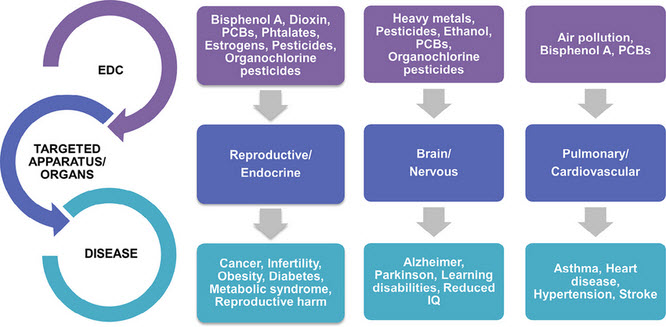Because of human activities, contaminants are continually being introduced into the environment, and this has dangerous public health implications. Some environmental contaminants are termed as “endocrine disrupting chemicals” (EDCs) because they have the ability to affect the normal function of the human body’s endocrine system. Even with minimal exposure, EDCs can have dire impacts on human health. These effects are more pronounced in young children and expectant mothers (EDCs can lead to birth defects). In this article, we discuss the effects of EDCs on human health, how EDCs are introduced into the environment, and what we should do to limit our exposure to EDCs.
What you need to know about the endocrine system
The endocrine system is a well-balanced network of organs, glands, and hormones which controls crucial body functions, including growth and development, metabolism, neurological functions, and response to environmental stimuli. This system governs sleep patterns, insulin production, blood pressure, and the ability to reproduce. The glands in the endocrine system produce hormones such as estrogen, insulin, testosterone, the thyroid hormone, and at least 50 others. The hormones travel to cell receptors throughout the body, triggering specific biological actions. The endocrine system is highly sensitive, meaning it can produce the right response even with extremely low concentrations of hormones.
The effects of endocrine disrupting chemicals (EDCs) on the human body
EDCs are chemicals which interfere with the normal working of hormones and the endocrine system in general. They can mimic certain hormones, affect their production, block them, prevent their movement through the body, or affect how they are metabolized. EDCs get into the body when we breathe in contaminated air, drink contaminated water, eat food with traces of EDCs, or if our skin comes into direct contact with them.
 Because EDCs prevent hormones from working normally, they can cause serious health complication to any body parts or functions that are serviced by the endocrine system. This means that EDCs could cause neurological, endocrine, reproductive, or metabolic complications. They can cause thyroid disorders, obesity, diabetes, early puberty, infertility, asthma, cancer (prostate or breast), ADHD, Parkinson’s, Alzheimer’s, among many other diseases and conditions.
Because EDCs prevent hormones from working normally, they can cause serious health complication to any body parts or functions that are serviced by the endocrine system. This means that EDCs could cause neurological, endocrine, reproductive, or metabolic complications. They can cause thyroid disorders, obesity, diabetes, early puberty, infertility, asthma, cancer (prostate or breast), ADHD, Parkinson’s, Alzheimer’s, among many other diseases and conditions.
Effects of EDCs can be manifested even if the body is exposed to a very low concentration of endocrine disrupting chemicals. The effects of EDCs also tend to vary depending on the concentration, which makes them hard to predict. If you are exposed to EDCs, it could take years, even decades for the effects to be manifested. In some cases, the effects of EDC exposure could even be hereditary.
How EDCs are introduced into the environment
EDCs can be found in everyday products, including personal care products, industrial chemicals, agricultural chemicals, pharmaceutical products, and construction materials. However, most synthetic EDCs come from by-products of unconventional fossil fuel exploration and processing. Oil and natural gas extraction methods such as hydraulic fracturing and horizontal drilling introduce several types of EDCs into the environment. The fracking process produces millions of gallons of wastewater that’s contaminated by salts and radioisotopes which have endocrine disruption properties. The wastewater comes back to the surface as “flow-back” and it may end up in water bodies. Some of it may remain below the surface and migrate over long distances, contaminating the groundwater in the surrounding area. In a study carried out in the USA, 24 fracking chemicals were tested, and 23 of them were found to be EDCs. Five different hormone receptors were also tested in the study, and all 5 of them were disrupted by chemicals found in fracking discharge.
What you can do to minimize your exposure to EDCs
As we’ve already mentioned EDCs get into our systems through water, air, food, or direct contact. We can minimize our exposure to EDCs by being vigilant. Ensure that you check the labels in your cosmetic and pharmaceutical products to ensure that they don’t contain EDCs. You can also ensure that the food you eat and the water you drink come from sources that you trust. At home and at your place of work, you can take measures to ensure that the indoor air isn’t contaminated with EDCs. If you are a business owner, you should consider hiring Environmental Consultants to assess the quality of indoor air in your offices to ensure your employees aren’t exposed to contaminated air.